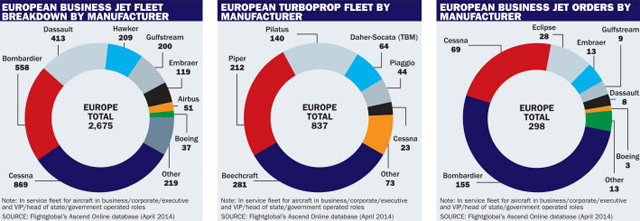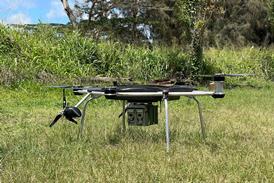It has been an unsettled six years for Europe’s business aviation sector. The region – home to the largest business jet fleet outside North America, with an installed base of nearly 2,700 aircraft – has been one of the major casualties of the economic crisis. Traditional buyers, from charter companies to corporates to high net-worths have abandoned the sector in their droves, forcing new aircraft orders and deliveries to plummet year on year from their historical peak in 2008.
The insipid economic recovery appears to be breathing some life back into the market, however. Last year marked the first signs of an uptick in sales and delivery numbers rebounded for the first time in four years – albeit moderately.
“Europe is slowly coming out of intensive care,” says Trevor Esling, Gulfstream's senior vice president, international sales, Europe, Middle East and Africa. “After years of oversupply and under purchase, things are starting to look more positive, but I think it will take at least another year before we can be confident of a full recovery.”
Esling says while the top end of the business aircraft sector has weathered the economic storm to a large degree, the mid to lower end of the business aircraft spectrum have been particularly hard hit, with sales of its midsize G150 cabin aircraft one of the many casualties of the consumer squeeze. “Traditional buyers of jets, such as small to medium-sized business and owner flyers, have not been buying,” he continues.
"There is definitely an interest there, but a lack of confidence in the market – be it the Ukraine crisis, China’s debt mountain – and this is causing many people to postpone that purchase,” Esling adds.
Richard Aboulafia, vice president of analysis at US-based Teal Group believes Europe’s fragile economies are the root cause of business aviation’s woes and the situation is unlikely to improve any time soon .
“Europe is recovering slowly because of the very difficult macroeconomic picture and credit environment,” he says. “It’s anyone's guess when Europe will show signs of a recovery, let alone a full return to health and growth. There is little that can be done aside from waiting for these factors to recover,” he adds.
Bombardier’s regional vice president of sales for western Europe, Trevor Lambarth, says new and upgraded products will help to draw the indecisive buyer back to the market and attract new business aircraft owners. “It’s all about timing,” he says.
“We are introducing a host of new products on to the European market this year for which we have received phenomenal interest during recent demonstration tours throughout the continent,” he continues. "The superlight Learjet 75 and light cabin Learjet 70 will enter service with European countries in the second half of 2014 and we also plan to deliver the first super-midsize Challenger 350 to European customers this year. Don’t forget. The type of customer who purchases a lighter business jet is making a much bigger decision [economically] that the guy purchasing a large jet," says Lambarth.
The pipeline of new products has helped Bombardier to secure over 50% of Europe’s business jet order tally with 155 aircraft, according to Flightglobal’s Ascend Online Fleets.
Lambarth, like Esling, suggests the fragile economic recovery across the region is creating some caution amongst potential buyers, but he says this ambivalence towards new aircraft acquisitions is nothing new. “I have experienced three economic downturns since I started working for Bombardier. This is the longest trough I have known, but don’t forget, the years before this downturn struck were the strongest the industry had ever experienced. Historically, the market is still doing relatively well."

Ascend’s data bears out Lambarth’s observation. In 2003 – during the previous business aviation downturn – business jet and turboprop deliveries totalled only 70 and 31 aircraft respectively. This compares with shipments of 132 jets and 21 turboprops in 2013.
During the market peak of 2008, however, a record 337 jets and 71 turboprops were delivered across Europe. “These numbers were artificially high,” concedes Lambarth. “We are unlikely to reach this level of activity for some time.”
Esling agrees. “Business aircraft shipments are much higher than during the previous downturns and the market is much healthier. For example, in the last four years, Gulfstream has seen its European fleet double from 100 to 200 business jets [representing 7.5% of the total fleet for the continent].” He adds: “If it is to fully recover, Europe needs a solid economic performance and no nasty shocks. After all, confidence is the main driver for anyone wishing to buy a multi-million dollar aircraft.”
Aviation analyst Brian Foley believes it will take at least a couple of years for Europe to return to a point where the majority of business aviation companies “feel secure and confident” about the future. “There’s nothing it can do but wait,” he says.
NEGATIVE IMAGE
While Europe’s business aviation community recuperates, its regional trade body, the European Business Aviation Association is training its focus on other major issues that are hampering industry recovery.
High on the “must-address” list is business aviation’s negative public image.
Private aircraft in Europe continue to be branded in some quarters as symbols of profligacy and elitism, despite the industry’s tireless work to prove that corporate aircraft are effective tools that help businesses to expand into global markets, create jobs and generate tax revenues. “People have short memories,” says Fabio Gamba, chief executive of the EBAA, which is also the co-founder of the annual European Business Aviation Convention and Exhibition.
He argues that in these frugal times, it is difficult to sell the concept of business aviation, despite its virtues. “There is a lot of scepticism,” he continues.
“Austerity doesn’t fit well with people’s perception of business aviation. In these difficult financial times, business aircraft are regarded as a luxury rather than a necessity.”
He believes it is time to “demystify” the image of business aviation and espouse its value not only to companies but also to the national economy.
Gamba points to an EBAA-sponsored study by Oxford Economics that found that the majority of business jet flights are used by key corporate decision-makers on high value-added trips. Additionally, the report reveals that each additional passenger flown on a business aviation flight generates the same GDP as nine business passengers on a scheduled flight.
“What this study clearly points out is that business aviation is playing a key role in facilitating Europe’s recovery,” Gamba notes. “We have to get that message across.”
"We also need to communicate the value that business aircraft place on people’s time," says Mark Wilson, president and chief operating officer of Europe’s largest business jet operator, NetJets.
“Business aircraft can access so many more airports in Europe than scheduled carriers can,” he says. “They offer flexibility and convenience and allow people to travel where they like and when they like.”
Gamba agrees: “There is a compelling case for business aircraft. We must rebrand business aviation so the man on the street has a better perception,” he says.
By doing so, Gamba argues, it will help to encourage more people to use business jets and help the continent’s struggling charter operators to attract more business. “We are currently operating at around 20% of our capacity. We need to attract a new market.”

Cessna certified the Sovereign+ at the end of last year
Cessna
ILLEGAL CHARTER
While refining the public’s image of business aviation is an imperative for the industry’s long-term prosperity, so too is stamping out the scourge of Europe’s illegal charter market.
The EBAA argues that these unlicensed operators are drawing business away from legitimate charter companies and threatening to undermine the industry’s professionalism.
German companies Roland Berger and Wingx Advance recently completed a study to measure the extent of unlicensed charter in Europe. The report found that 14% – around 650,000 – of business aircraft movements in Europe may not be meeting all regulatory requirements at a cost to the sector estimated to be more than €850 million ($1.18 billion) a year.
Legitimate charter companies argue that commercial services – offering flights in return for payment – are being provided by companies and individuals who do not hold an aircraft operator's certificate. “Having an AOC means they are regularly checked out [by the national aviation authority] to ensure they maintain and operate their aircraft to stringent commercial air transport standards,” says Gamba. "Anyone requesting payment for flights without an AOC is breaking the law, putting passengers at risk and may be invalidating the life insurances of all on board."
The EBAA says it will present the findings to the European Commission and the national aviation authorities shortly and work with them to come up with a solution. Gamba says it is not looking for a heavy-handed approach from the regulators. “We just want a fair system for all,” he adds.
Charter operators, the EBAA argues, face costly and onerous operating requirements in Europe compared with the light-touch approach applied to their private counterparts. “The legislation is poorly crafted so it forces people to cheat or cut corners. The regulations need to be more proportionate,” Gamba adds.
AIRPORT ACCESS
This equitable approach would also be welcomed across Europe’s main hubs – Frankfurt, Germany and Geneva, for example, where business aviation continues to play second fiddle to the more lucrative commercial airlines. “Flexible access to airports is the cornerstone of business aviation,” says Gamba. “Traffic is increasing but there are no new runways being built in Europe. We need a suitable alternative when access to the major slot-controlled airports is denied.”
The answer lies in the continent’s vast network of secondary airports. The EBAA is calling for these facilities to be equipped with precision landing aids to a Category 1 approach standard to allow operations in most weather conditions.
“So far only 120 tertiary airports are equipped for Cat 1 approaches or similar. We need at least 10 times more than that,” says Gamba.
Wilson agrees. “Any major hub will create major difficulties [for business aircraft operators] at some time. By developing all-weather approaches to nearby secondary airports, we can continue to service the needs of our customers,” he says.
Wilson and Gamba cite London as a “great destination for business aircraft” with at least three airports – Farnborough, Biggin Hill and Luton – serving the sector outside the major slot controlled hubs of Gatwick and Heathrow.
NetJets’ battle to secure regular and sustained access to Frankfurt airport persuaded it in 2011 to purchase nearby Frankfurt-Egelsbach airport.
The acquisition marked the fractional ownership operator’s first and only foray into airport ownership. It was a strategic move. Not only has Egelsbach opened up the lucrative German market for the Berkshire Hathaway-owned company, it has also given its customers unfettered access to Germany’s financial capital. “We can now fly to Frankfurt at times convenient to our customers, rather than the airport," says Wilson.
No further airport acquisitions are planned, he points out, but NetJets is keen to see business aircraft operators with established and regular service to a particular airport being granted historic rights to that slot. “When an airport reaches capacity, slot allocation is skewed in favour of the airlines,” he says.
Business aircraft operations are defined as ad hoc and are not afforded the same rights at airports as their scheduled counterparts. “This needs to change. If business aircraft operators meet the same criteria as the airlines – the same slot, same time, same number each season, we should be given historic rights to that slot,” says Wilson."
For the EBAA access rights, public image and illegal charter activity are key battlegrounds in the fight to restore business aviation to its former glory.
“We have to increase our visibility, widen our appeal, convince policy makers of the value of the sector and let them know that we are a force to be reckoned with,” says Gamba.
Source: FlightGlobal.com
















